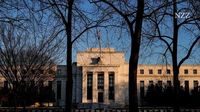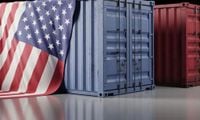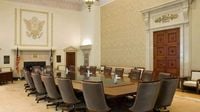On Wednesday, May 7, 2025, the Federal Reserve, led by Chairman Jerome Powell, announced that it would maintain the key interest rate in the range of 4.25 to 4.50 percent. This decision comes amid increasing pressure from U.S. President Donald Trump, who has been vocally advocating for a rapid rate cut to stimulate the economy. Despite the political pressure, the Fed's decision reflects a cautious approach, as it seeks to assess the impact of ongoing trade tensions and inflationary risks.
The Fed's decision to hold the interest rate steady was widely anticipated by economists and market analysts. Thomas Gitzel, Chief Economist at VP Bank Group, noted, "Fed Chairman Jerome Powell wants to see inflationary dangers quelled before any rate cuts are considered. This will likely not happen at the next meeting in June, and further monetary easing is expected only in the fall months." His comments highlight the central bank's commitment to prioritizing economic stability over political pressures.
In recent months, the economic landscape has shifted dramatically, with the U.S. economy experiencing a surprising contraction of 0.3 percent in the first quarter of 2025. This decline has raised concerns about the potential for higher unemployment and inflation, as the Fed's statement acknowledged the growing uncertainty surrounding the economic outlook. The Fed's assessment indicated that risks of both higher unemployment and inflation had increased, a sentiment echoed by several economists.
Bastian Hepperle, Executive Director of Financial Markets Sales at Hauck Aufhäuser Lampe, suggested that the Fed might lower the key interest rate in September 2025, depending on how the economic situation evolves. He stated, "The Fed is not yielding to President Trump and is demonstrating its independence. However, increasing economic and inflation risks are pushing the Fed into a conflict of goals. For now, it will maintain its position and wait for more clarity." This viewpoint underscores the Fed's cautious stance amid political pressures.
Elmar Völker, a senior fixed-income analyst at LBBW Research, also emphasized the Fed's resistance to Trump's demands, stating, "The U.S. central bankers have resisted the repeated calls from Donald Trump for swift rate cuts. A capitulation to the President—especially without clear economic indicators favoring monetary easing—would undermine the Fed's independence in the eyes of many market participants." This highlights the delicate balance the Fed must maintain between its independence and the political climate.
Michael Heise, Chief Economist at HQ Trust, warned that if Trump continues his aggressive tariff policy, it could create significant challenges for the Fed. He noted, "The more import tariffs rise and thereby fuel inflation in the U.S., the less likely rate cuts will be as the year progresses. The Federal Reserve will then have to accept substantial economic slowdowns to ensure price level stability." This reflects the potential ramifications of Trump's trade policies on the broader economy.
Lena Dräger, Director of Research at IFW, pointed out that current data supports a wait-and-see approach, as inflation has stabilized at just over 2 percent since the beginning of the year, while the labor market remains resilient despite political uncertainties. She stated, "The Fed has repeatedly emphasized that monetary policy decisions must be made independently and should be based solely on the economic situation. The current data continues to support a cautious stance with unchanged rates."
Trump's aggressive trade policies, including tariffs on various goods, have created a complex backdrop for the Fed's decision-making. On April 2, 2025, Trump imposed tariffs of 10 percent against imports from most countries, alongside higher tariffs on numerous trading partners. The President has also implemented 25 percent tariffs on cars, steel, and aluminum, as well as substantial tariffs on imports from China. These measures have raised concerns about their potential impact on inflation and economic growth.
The uncertainty surrounding Trump's trade policies has led to heightened volatility in financial markets. The U.S. stock market reacted negatively to the Fed's announcement, while U.S. Treasury yields fell, indicating investor caution. The Fed's decision to maintain the interest rate reflects its desire to avoid appearing influenced by political pressure, particularly from the President.
Despite the challenges posed by Trump's tariff policies, Powell has maintained that the Fed's mandate is to ensure price stability and full employment. He stated, "The costs of waiting are quite low," suggesting that the Fed is prepared to act when necessary but is currently in a position to monitor economic developments closely. Powell's comments indicate that the Fed is committed to its dual mandate while navigating the complexities of the current economic environment.
As the Fed continues to assess the economic landscape, it faces a challenging dilemma. The potential for stagflation—a period of stagnant economic growth combined with inflation—looms large, as tariffs may drive prices higher while simultaneously dampening economic activity. Don Rissmiller, Chief Economist at Strategas, remarked, "The situation is very difficult, as tariffs are likely to trigger a stagflationary shock. Tariffs will fuel prices, while the labor market is simultaneously at risk from economic slowdown."
The Fed's decision to hold rates steady reflects a broader strategy to maintain its independence and avoid succumbing to political pressures. As Trump continues to advocate for lower interest rates, the Fed remains focused on its economic indicators and the potential long-term impacts of trade policies. Powell has emphasized that the Fed will respond as needed but is currently adopting a cautious approach to ensure stability in the economy.
In conclusion, the Federal Reserve's decision to maintain the key interest rate amid political pressure from President Trump underscores the delicate balance between economic stability and political influence. As the economy grapples with the effects of trade tensions and inflationary risks, the Fed's cautious stance may be crucial in navigating the uncertainties ahead.



